| Columns Retired Columns & Blogs |
In the same chasis, but the inards have been completely updated in 2011 I believe.
I examined the Klimax DS's measured behavior mainly using Audio Precision's top-model SYS2722 system. I primarily used the Linn's balanced outputs, though I did spot checks on the unbalanced outputs. My files for testing digital components are archived as AIF files, but because the Klimax doesn't recognize that format, I first had to transcode them all to WAV files, then copy them over the WiFi network to a new folder, imaginatively titled "Test Tones," which I created on the big NAS drive supplied by Linn for this review. I could then navigate to the folder using the Linn control program on the tablet PC they had supplied and create a new playlist (fig.1).
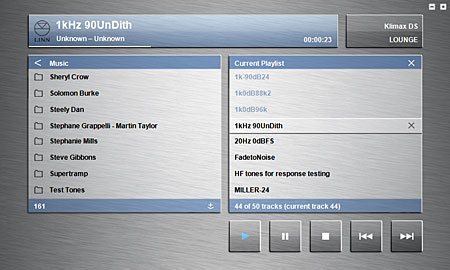
Fig.1 Linn GUI running on laptop PC and showing test-tone playlist.
The only practical difficulties I had using the Klimax involved my not realizing at first that the Klimax, the NAS drive, and the WiFi hub all need to be plugged into the same router. Once I had that sorted out, all worked fine, though, as WP pointed out, the Linn GUI is at present a bit bare-bones.
The Klimax successfully decoded 16- and 24-bit data sampled at 44.1, 48, 88.2, and 96kHz. (I didn't try 192kHz files.) Its maximum output level at 1kHz was 4.04V balanced, 2.02V unbalanced, and both outputs preserved absolute polarity; ie, were non-inverting. The output impedance at 1kHz was 194 ohms from the balanced XLRs, 237 ohms from the unbalanced RCAs. Unusually, this rose at 20kHz, to 352 ohms balanced and 1k ohm unbalanced. This will have no audible consequences unless the Klimax is used with a preamp having a very low input impedance.
Fed 96kHz-sampled data, the Klimax had a perfectly flat response up to 35kHz, with then a sharp rolloff reaching –8dB at 40kHz and –40dB at 45kHz (fig.2). Some feel that a slight degree of response droop in the octave below the Nyquist Frequency (half the sample rate) is preferable on grounds of sound quality, but it appears the Klimax DS gives the lie to that belief. Channel separation was superb, at >130dB below 1kHz.
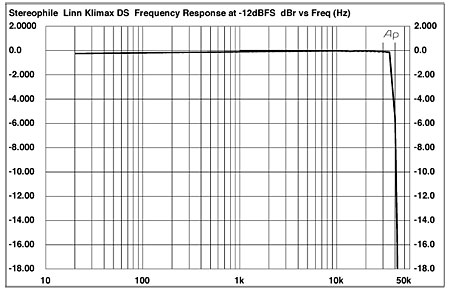
Fig.2 Linn Klimax DS, frequency response at –12dBFS into 200k ohms, 96kHz data (blue, left; red, right; 2dB/vertical div.).
For consistency with previous reports, I still examine a digital component's resolution by sweeping a 1/3-octave bandpass filter from 20kHz to 20Hz with the Audio Precision System One. The results are shown in fig.3. The top pair of traces were taken with the Klimax decoding dithered 16-bit data representing a 1kHz tone at –90dBFS. The spectra peak at exactly –90dB and the smooth noise floor is actually that of the recorded dither. Increasing the word length to 24 bits gave the middle pair of traces in this graph. The noise floor drops by 15dB across almost the entire audioband, suggesting that the DAC resolution is almost 19 bits—excellent performance. Note also that the increase in bit depth hasn't unmasked any AC-supply components, indicating optimal power-supply design and circuit layout. A slight bump at 3kHz, however, indicates a trace of third-harmonic distortion.
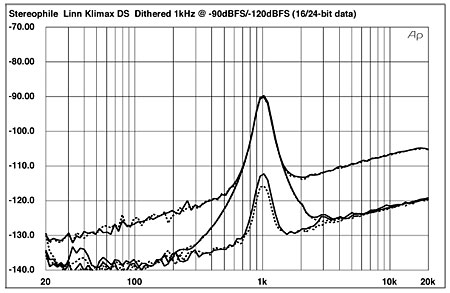
Fig.3 Linn Klimax DS, 1/3-octave spectrum with noise and spuriae of (from top to bottom at 3kHz): dithered 1kHz tone at –90dBFS with 16- and 24-bit data; dithered 1kHz tone at –120dBFS with 24-bit data (right channel dashed).
Increasing the measurement bandwidth to 20kHz and repeating the spectral analysis with the Klimax decoding 16-bit data representing a 1LSB DC offset revealed a slight peak of ultrasonic noise at 4x the sample rate, but this was still very low in absolute terms (not shown).
The bottom pair of traces in fig.3 are spectra taken with a dithered 24-bit/1kHz tone at –120dBFS. Again a slight bump at 3kHz can be seen, this confirmed with FFT analysis (not shown). But peculiarly, the spectra peak at –113dB (left) and –117dB (right) rather than the expected –120dB. It appears that the DAC chip used in the Klimax (the WM8741, I believe) develops some positive linearity error below –110dBFS. While this is intriguing, I don't think it consequential. Testing for linearity with 16-bit data indicated that any DAC error lay below the 16-bit dither noise down to levels below –115dBFS.
With its very low level of analog noise and excellent linearity, the Klimax reproduced an undithered 1kHz tone at exactly –90.31dBFS with excellent resolution of the signal's three DC levels (fig.4). Increasing the word length to 24 bits gave a well-shaped sinewave (fig.5).
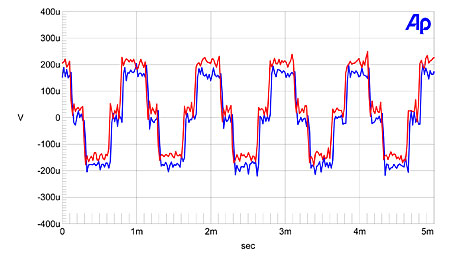
Fig.4 Linn Klimax DS, waveform of undithered 1kHz sinewave at –90.31dBFS, 16-bit data.
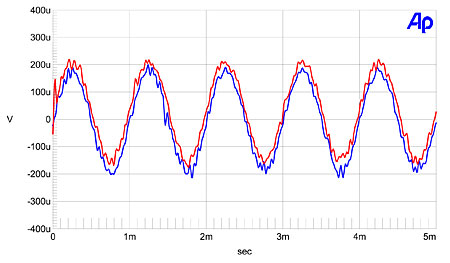
Fig.5 Linn Klimax DS, waveform of undithered 1kHz sinewave at –90.31dBFS, 24-bit data.
Driving a 24-bit 1kHz tone into high impedances, the Klimax produced low levels of distortion, with the second harmonic at –100dBFS (0.001%) and the third harmonic at –94dBFS (0.002%) being the highest in level (fig.6). The fifth harmonic also made an appearance, though at –109dB, this won't be significant. The spectrum measured at the unbalanced outputs was not significantly different. Tested into the punishing 600 ohm load, the Klimax actually showed a lower level of second harmonic and a slightly higher level of fifth, though the third remained unchanged. The noise floor started to show some granularity, however, suggesting that the Klimax not be used with loads this low. Fig.6 indicated that the right channel was very slightly less linear than the left. This can also be seen in fig.7, which shows the Linn's output spectrum with the processor reproducing a 50Hz tone into 200k ohms. All the distortion components are higher than in the midrange, with the third harmonic still the highest in level at –74dB (0.02%). A regular series of higher-order components makes an appearance, though their absolute level is still very low.
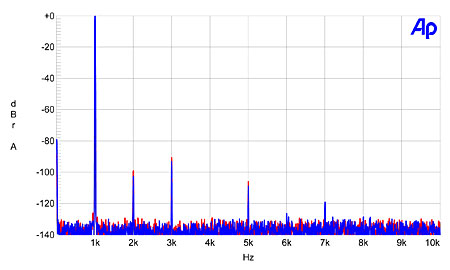
Fig.6 Linn Klimax DS, spectrum of 1kHz sinewave at 0dBFS into 200k ohms (blue, left; red, right; linear frequency scale).
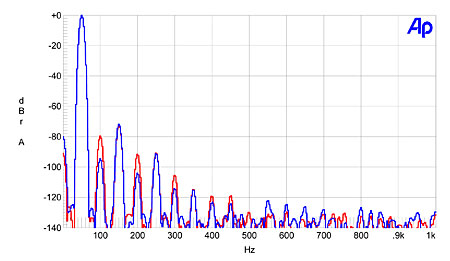
Fig.7 Linn Klimax DS, spectrum of 50Hz sinewave at 0dBFS into 200k ohms (blue, left; red, right; linear frequency scale).
Tested with the demanding mixture of 19 and 20kHz tones, the Klimax did very well, with all intermodulation components at or below –100dB referred to the peak level of the combined waveform (fig.8). This excellent behavior was identical from the unbalanced outputs and into low impedances. Tested for its rejection of word-clock jitter, the Klimax performed superbly. When the Klimax DS was fed a 24-bit version of the Miller/Dunn J-Test tone and tested with the Miller Audio Research Jitter Analyser, a pair of sidebands appeared at ±1.5kHz (not shown), with a total jitter level of 200 picoseconds peak–peak. This is superb performance; however, the Linn's spectrum with the same data assessed with the Audio Precision 2722 was free from jitter-related sidebands (fig.9).
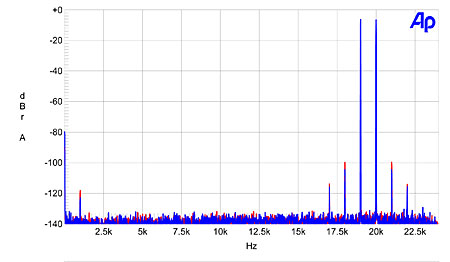
Fig.8 Linn Klimax DS, HF intermodulation spectrum, 19+20kHz at 0dBFS peak into 200k ohms (blue, left; red, right; linear frequency scale).
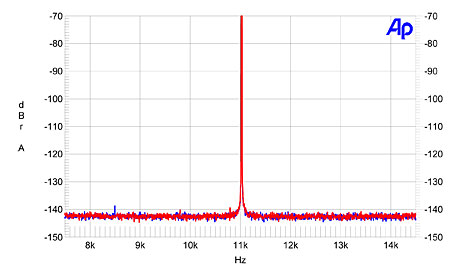
Fig.9 Linn Klimax DS, high-resolution jitter spectrum of analog output signal, 11.025kHz at –6dBFS, sampled at 44.1kHz with LSB toggled at 229Hz, 24-bit data. Center frequency of trace, 11.025kHz; frequency range, ±3.5kHz.
This is excellent measured performance. After I had finished testing the Klimax DS, I loaded some of my hi-rez master files on the NAS—specifically the 24-bit, 88.2kHz master files for Attention Screen's Live at Merkin Hall—and gave a listen. Wes had it right: this is one great-sounding component, particularly in its freedom from high-frequency grain and its low-frequency definition. Wow!—John Atkinson

In the same chasis, but the inards have been completely updated in 2011 I believe.